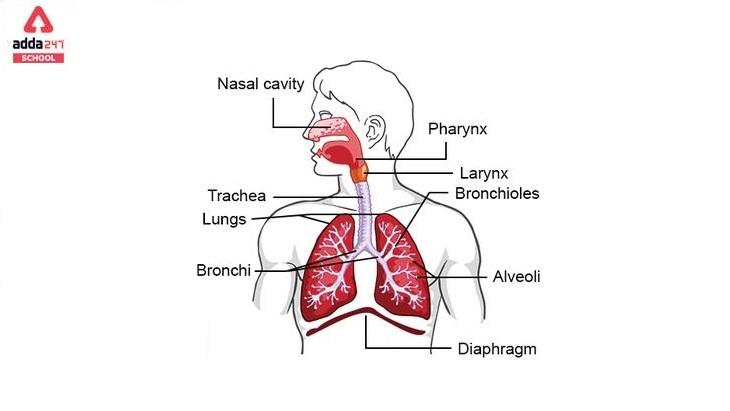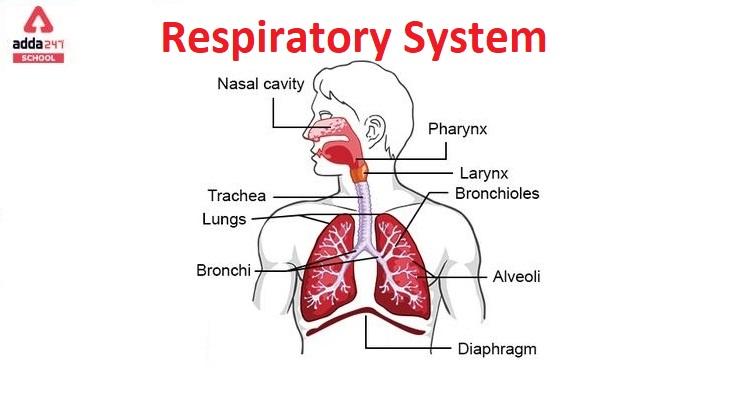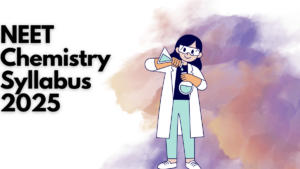Table of Contents
Respiratory System in English
The respiratory system, also known as the respiratory apparatus or the ventilatory system, is a system that allows you to breathe. The respiratory system is a biological system in animals and plants that consists of specialised organs and structures for gas exchange, but the anatomy and physiology that allows this to happen varies widely depending on a variety of circumstances. The parameters are determined by the organism’s size, its environment, and its evolutionary history.
Parts of Respiratory System
The respiratory system is a complex network of organs and tissues that work together to facilitate the exchange of gases, primarily oxygen and carbon dioxide, between the body and the external environment. The main parts of the respiratory system include:
- Nasal Cavity: The nasal passages are lined with mucus-producing cells and tiny hairs called cilia, which help filter and humidify the air as it is inhaled.
- Pharynx (Throat): The pharynx is a muscular tube at the back of the mouth that serves as a common passageway for both air and food. It leads to two separate pathways: the trachea (for air) and the esophagus (for food).
- Larynx (Voice Box): The larynx contains the vocal cords, which vibrate to produce sound when air passes over them. It also acts as a valve that helps prevent food and liquids from entering the trachea during swallowing.
- Trachea (Windpipe): The trachea is a tube composed of cartilage rings that connects the larynx to the bronchi. It conducts air to and from the lungs.
- Bronchi: The trachea divides into two bronchi, one leading to each lung. The bronchi further branch into smaller bronchioles, which distribute air throughout the lungs.
- Lungs: The two lungs are the primary organs of the respiratory system and are responsible for the exchange of gases. They are composed of lobes and contain millions of tiny air sacs called alveoli, where the actual exchange of oxygen and carbon dioxide occurs.
- Alveoli: These are small, thin-walled sacs within the lungs where oxygen from inhaled air is transferred to the bloodstream, and carbon dioxide from the bloodstream is expelled into the exhaled air.
- Diaphragm: The diaphragm is a dome-shaped muscle located at the base of the lungs. It plays a critical role in the process of breathing by contracting and relaxing to change the volume of the thoracic cavity, thus creating the pressure gradient that allows air to flow in and out of the lungs.
- Rib Cage: The rib cage protects the lungs and provides structural support for the process of breathing. Muscles between the ribs, known as intercostal muscles, help with breathing by expanding and contracting the chest.
- Pleura: The pleura is a double-layered membrane that surrounds each lung. The outer layer, called the parietal pleura, lines the chest cavity, while the inner layer, the visceral pleura, adheres to the surface of the lung. The pleura contains a small amount of lubricating fluid that reduces friction between the lung and chest wall during breathing.
These components work together to allow the inhalation of oxygen and the exhalation of carbon dioxide, supporting the body’s oxygenation and removal of waste gases.
Respiratory System Parts Name
The respiratory system is a complex system responsible for the exchange of oxygen and carbon dioxide in the body. It includes several key parts and structures. Here’s a list of some of the main components of the respiratory system:
- Nose: The nose is the primary entry point for air. It filters, warms, and humidifies the incoming air.
- Nasal Cavity: The nasal cavity is the space inside the nose. It contains cilia and mucus that further filter and humidify the air.
- Pharynx: The pharynx, or throat, is a passage that connects the nasal cavity and the mouth to the larynx and esophagus.
- Larynx: The larynx, or voice box, contains the vocal cords and is responsible for producing sound.
- Trachea: The trachea, also known as the windpipe, is a tube that carries air from the larynx to the bronchi.
- Bronchi: The bronchi are two main airways that branch off from the trachea, with one leading to each lung.
- Lungs: The lungs are the primary organs of respiration and contain bronchial tubes, air sacs (alveoli), and blood vessels. They facilitate the exchange of oxygen and carbon dioxide.
- Bronchioles: Bronchioles are smaller airways that branch off from the bronchi and lead to the alveoli.
- Alveoli: Alveoli are tiny air sacs within the lungs where the exchange of oxygen and carbon dioxide takes place.
- Diaphragm: The diaphragm is a muscle at the base of the chest that plays a crucial role in breathing. When it contracts, it expands the chest cavity, allowing air to be drawn into the lungs. When it relaxes, it expels air from the lungs.
- Intercostal Muscles: These muscles are located between the ribs and assist in expanding and contracting the chest during breathing.
- Pleura: The pleura is a membrane that surrounds each lung, providing lubrication and facilitating the movement of the lungs within the chest cavity.
- Respiratory Center: The respiratory center in the brainstem controls the rate and depth of breathing, ensuring that oxygen levels are maintained and carbon dioxide is expelled.
- Phrenic Nerves: The phrenic nerves are responsible for controlling the diaphragm’s movement, allowing it to contract and relax during breathing.
These are the major parts and structures of the respiratory system, working together to facilitate the exchange of gases necessary for the body’s survival.
Respiratory System Diagram
The respiratory surface of land animals is internalized as lungs’ linings, and gas exchange in the lungs happens in millions of minute air sacs. These little air sacs are referred to as alveoli in mammals and reptiles, and atria in birds.
The blood supply to these small air sacs is abundant. They bring the air into close touch with the blood before communicating with the outside world. This connection is accomplished through a series of airways, or hollow tubes, the largest of which is the trachea. The trachea divides into two main bronchi in the middle of the chest, which enter the lungs and branch into progressively narrower secondary and tertiary bronchi. These branch out into a slew of bronchioles. In animals, it is the bronchioles that open into the minuscule alveoli. The process of breathing, which involves the muscles of respiration, must pump air from the environment into the alveoli.
Respiratory System Diagram is given below.

Respiratory System Function
The respiratory system is a crucial physiological system in the human body responsible for several essential functions. Its primary function is to facilitate the exchange of gases, particularly oxygen and carbon dioxide, between the body and the external environment. Here are the key functions of the respiratory system:
- Gas Exchange: The main function of the respiratory system is the exchange of gases between the body and the environment. It involves two processes:
- Inhalation (Breathing In): During inhalation, oxygen-rich air is drawn into the lungs. This oxygen is essential for cellular respiration, where it is used to produce energy.
- Exhalation (Breathing Out): During exhalation, carbon dioxide, a waste product of cellular respiration, is expelled from the body into the external environment.
- Oxygen Transport: Once oxygen is inhaled and diffuses into the bloodstream, the respiratory system helps transport it to cells and tissues throughout the body. Oxygen is carried by hemoglobin in red blood cells.
- Carbon Dioxide Removal: The respiratory system also removes carbon dioxide, which is produced as a metabolic waste product. Carbon dioxide is transported in the blood back to the lungs and expelled from the body during exhalation.
- Regulation of Acid-Base Balance: By controlling the levels of carbon dioxide in the blood, the respiratory system helps maintain the body’s acid-base balance (pH). Proper pH is crucial for various physiological processes.
- Filtering and Humidifying Inhaled Air: The respiratory system filters and humidifies the air we breathe. Tiny hairs (cilia) in the respiratory tract trap dust and particles, while the mucus lining helps remove them. This process helps protect the lungs from harmful substances.
- Immune Defense: The respiratory system has immune functions. It includes mucous membranes, immune cells, and antibodies that help protect the body against respiratory infections and foreign invaders.
- Speech and Vocalization: The movement of air through the vocal cords in the larynx (voice box) allows humans to produce speech and sound.
- Thermoregulation: The respiratory system can also play a role in regulating body temperature. When you exhale, you release heat from your body, which can help with temperature regulation in certain situations.
The respiratory system consists of several organs and structures, including the nose, mouth, pharynx, larynx, trachea, bronchi, bronchioles, and lungs. It works in coordination with the circulatory system to ensure the body receives the necessary oxygen and expels waste carbon dioxide. Proper functioning of the respiratory system is vital for overall health and survival.
Respiratory System Organs in Anatomy
Horses are required to breathe via their noses. They are unable to breathe via their mouth and must instead breathe through their nostrils.
Furthermore, the elephant is the only mammal with no pleural gap, and both the parietal and visceral pleurae are made up of dense connective tissue. These are connected through loose connective tissue. The absence of a pleural gap, as well as a diaphragm that is exceptionally thick, are regarded to represent evolutionary adaptations. It permits the elephant to breathe through its trunk while submerged for long periods of time. The lungs are connected to the diaphragm, and the diaphragm is primarily responsible for breathing.Respiratory System Function in Aquatic Animals
The respiratory system of aquatic animals is made up of gills. These gills are external organs, either partially or entirely. Water passes over the gills in a variety of active and passive ways, and the gills’ gas exchange system is made up of thin or extremely flat filaments and lamellae that expose a huge surface area of highly vascularized tissue to the water.
Respiratory System Function in Animals/Insects
In insects, there are respiratory systems with very basic anatomical properties. Even the skin of amphibians plays an important function in gas exchange. Plants have respiratory systems as well, although the directionality of gas exchange differs from that of animals, and includes physical elements such as stomata present throughout the plant.
Respiratory System of Honey Bee
Lungs are not present in bees. They do, however, have tracheal sacs, which are found in the head and throughout the body. Bees breathe by inhaling through spiracles, which are ten pairs of openings. Old air is squeezed from the tracheal sacs as a bee contracts its abdominal muscles. It leaves the body via the spiracles. Fresh air is taken in through the spiracles and into the tracheal system as the abdomen relaxes again. It is then circulated throughout the body, including the brain, thorax, and abdomen. Valves in bees regulate the flow of air into and out of the spiracles.
Human Respiratory System Anatomy
Humans have a complex respiratory system with many different parts that work together to help you breathe, and each group of parts has its own set of components.
Mouth and nose; Sinuses, which are hollow areas between the bones in your head that help regulate the temperature of inhaled air; Pharynx or the windpipe; Trachea, the passage connecting throat and lungs; Bronchial tubes, which connect into each lung; and Lungs are the airways that deliver air to the lungs. The circulation transports oxygen from the lungs to all of the human organs and tissues.
Muscles and bones are also essential because they aid in the movement of air into and out of the lungs.
The blood takes carbon dioxide and other waste out of the body as you breathe out. The respiratory system also includes alveoli, bronchioles, capillaries, lung lobes, and the pleura.
रेस्पिरेटरी सिस्टम- Respiratory System Meaning in Hindi
श्वसन प्रणाली, जिसे श्वसन तंत्र या वेंटिलेटरी सिस्टम के रूप में भी जाना जाता है, एक ऐसी प्रणाली है जो आपको सांस लेने की अनुमति देती है। श्वसन प्रणाली जानवरों और पौधों में एक जैविक प्रणाली है जिसमें गैस विनिमय के लिए विशेष अंग और संरचनाएं होती हैं, लेकिन शरीर रचना और शरीर विज्ञान जो इसे होने की अनुमति देता है, विभिन्न परिस्थितियों के आधार पर व्यापक रूप से भिन्न होता है। पैरामीटर जीव के आकार, उसके पर्यावरण और उसके विकासवादी इतिहास द्वारा निर्धारित किए जाते हैं। जमीन के जानवरों की श्वसन सतह फेफड़ों के अस्तर के रूप में आंतरिक होती है, और फेफड़ों में गैस का आदान-प्रदान लाखों मिनट की वायु थैली में होता है। इन छोटे वायुकोशों को स्तनधारियों और सरीसृपों में एल्वियोली और पक्षियों में अटरिया कहा जाता है।
इन छोटी वायुकोशों में रक्त की आपूर्ति प्रचुर मात्रा में होती है। वे बाहरी दुनिया के साथ संचार करने से पहले हवा को रक्त के निकट संपर्क में लाते हैं। यह कनेक्शन वायुमार्ग, या खोखले ट्यूबों की एक श्रृंखला के माध्यम से पूरा किया जाता है, जिनमें से सबसे बड़ा श्वासनली है। श्वासनली छाती के बीच में दो मुख्य ब्रांकाई में विभाजित होती है, जो फेफड़े और शाखा में उत्तरोत्तर संकरी माध्यमिक और तृतीयक ब्रांकाई में प्रवेश करती है। ये शाखा ब्रोंचीओल्स के एक समूह में बदल जाती है। जानवरों में, यह ब्रोन्किओल्स हैं जो माइनसक्यूल एल्वियोली में खुलते हैं। सांस लेने की प्रक्रिया, जिसमें श्वसन की मांसपेशियां शामिल हैं, को वातावरण से वायु को एल्वियोली में पंप करना चाहिए।
जलीय जंतुओं का श्वसन तंत्र गलफड़ों का बना होता है। ये गलफड़े बाहरी अंग हैं, या तो आंशिक रूप से या पूरी तरह से। पानी विभिन्न प्रकार के सक्रिय और निष्क्रिय तरीकों से गलफड़ों के ऊपर से गुजरता है, और गलफड़ों की गैस विनिमय प्रणाली पतली या अत्यंत सपाट तंतुओं और लैमेली से बनी होती है जो पानी के लिए अत्यधिक संवहनी ऊतक के एक विशाल सतह क्षेत्र को उजागर करती है।
कीड़ों में, बहुत ही बुनियादी शारीरिक गुणों वाले श्वसन तंत्र होते हैं। उभयचरों की त्वचा भी गैस विनिमय में महत्वपूर्ण भूमिका निभाती है। पौधों में श्वसन प्रणाली भी होती है, हालांकि गैस विनिमय की दिशा जानवरों से भिन्न होती है, और इसमें पूरे पौधे में मौजूद रंध्र जैसे भौतिक तत्व शामिल होते हैं।


 NEET Chemistry Syllabus 2025, Check Clas...
NEET Chemistry Syllabus 2025, Check Clas...
 NEET UG 2025 News: Check NEET Exam Mode
NEET UG 2025 News: Check NEET Exam Mode
 CBSE Board Exams 2025 Latest News- Recen...
CBSE Board Exams 2025 Latest News- Recen...





























